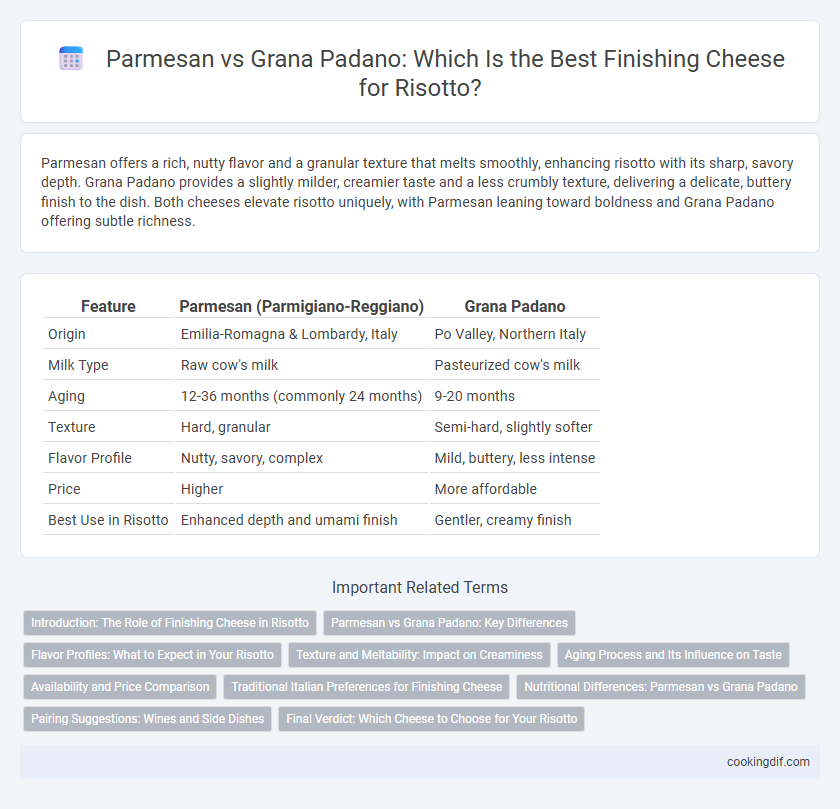Parmesan offers a rich, nutty flavor and a granular texture that melts smoothly, enhancing risotto with its sharp, savory depth. Grana Padano provides a slightly milder, creamier taste and a less crumbly texture, delivering a delicate, buttery finish to the dish. Both cheeses elevate risotto uniquely, with Parmesan leaning toward boldness and Grana Padano offering subtle richness.
Table of Comparison
| Feature | Parmesan (Parmigiano-Reggiano) | Grana Padano |
|---|---|---|
| Origin | Emilia-Romagna & Lombardy, Italy | Po Valley, Northern Italy |
| Milk Type | Raw cow's milk | Pasteurized cow's milk |
| Aging | 12-36 months (commonly 24 months) | 9-20 months |
| Texture | Hard, granular | Semi-hard, slightly softer |
| Flavor Profile | Nutty, savory, complex | Mild, buttery, less intense |
| Price | Higher | More affordable |
| Best Use in Risotto | Enhanced depth and umami finish | Gentler, creamy finish |
Introduction: The Role of Finishing Cheese in Risotto
Finishing cheese enhances risotto's creamy texture and rich flavor, with Parmesan and Grana Padano as premier choices. Parmesan offers a sharper, nuttier profile and a granular texture that melts smoothly into risotto, elevating its umami depth. Grana Padano presents a milder, creamier taste with less aging, suitable for those seeking a delicate finish without overpowering the dish.
Parmesan vs Grana Padano: Key Differences
Parmesan and Grana Padano are both Italian hard cheeses used for finishing risotto, but Parmesan, or Parmigiano-Reggiano, is aged longer, typically 12 to 36 months, resulting in a more complex, nuttier flavor and granular texture. Grana Padano is aged for a shorter period, around 9 to 16 months, offering a milder, creamier taste with slightly less granular texture. Parmesan's strict production regulations and longer aging contribute to its higher price point and more intense umami profile, while Grana Padano provides a more affordable, versatile option with a subtle, sweet finish.
Flavor Profiles: What to Expect in Your Risotto
Parmesan offers a sharp, nutty flavor with deep umami notes that enhance the richness of risotto, creating a savory depth and smooth finish. Grana Padano presents a milder, slightly sweet taste with a creamy texture, contributing a subtle savory balance without overpowering delicate ingredients. Choosing Parmesan intensifies the risotto's complexity, while Grana Padano delivers a gentler, more harmonious flavor profile.
Texture and Meltability: Impact on Creaminess
Parmesan cheese offers a granular texture and intense umami flavor that enhances risotto's creaminess through gradual melting and subtle thickening. Grana Padano provides a slightly softer texture with higher moisture content, allowing it to melt more quickly and create a smoother, silkier finish. Choosing between Parmesan and Grana Padano directly influences the risotto's final mouthfeel, balancing meltability and texture for optimal creaminess.
Aging Process and Its Influence on Taste
Parmesan, aged for a minimum of 12 months and often up to 36 months, develops a complex, nutty, and sharp flavor that intensifies with time, making it ideal for adding depth to risotto. Grana Padano, aged between 9 to 24 months, offers a milder, creamier taste with a subtle sweetness, which provides a delicate finish to the dish. The longer aging process of Parmesan results in crumblier texture and more pronounced umami, while Grana Padano's shorter aging retains a smoother consistency and gentler flavor profile.
Availability and Price Comparison
Grana Padano is widely available and typically less expensive than Parmesan, making it a cost-effective choice for finishing risotto without compromising flavor. Parmesan, known as Parmigiano-Reggiano, commands a higher price due to its longer aging process and strict production standards, which contribute to its richer, nuttier taste. Both cheeses enhance risotto's creaminess, but availability and budget constraints often guide the decision between Grana Padano and Parmesan.
Traditional Italian Preferences for Finishing Cheese
Traditional Italian risotto recipes often favor Parmesan (Parmigiano-Reggiano) for finishing due to its intense umami flavor and granular texture that melts smoothly into the creamy rice. Grana Padano is frequently chosen as a more affordable alternative, offering a slightly milder taste and less granular consistency while still enhancing the dish's richness. Italian cooks value the regional origin and aging period of cheese, with Parmesan aged at least 12 months delivering a more complex finish compared to Grana Padano's younger, slightly sweeter profile.
Nutritional Differences: Parmesan vs Grana Padano
Parmesan cheese contains higher protein levels and essential amino acids compared to Grana Padano, enhancing the risotto's nutritional profile with more complete proteins. Grana Padano typically has lower fat content and slightly less sodium, making it a lighter option for heart-conscious diners. Both cheeses offer rich calcium and phosphorus, but Parmesan's aging process increases bioavailability, benefiting bone health more effectively.
Pairing Suggestions: Wines and Side Dishes
Parmesan's nutty and rich flavor pairs exceptionally well with full-bodied red wines like Barolo or Chianti, enhancing the creamy texture of risotto, while Grana Padano, milder and less aged, complements lighter wines such as Pinot Grigio or Soave. Side dishes like roasted mushrooms or sauteed asparagus match Parmesan's intensity, whereas Grana Padano pairs beautifully with fresh salads or steamed vegetables, balancing the dish's delicate flavors. Choosing the cheese and pairing accordingly elevates the overall tasting experience of risotto.
Final Verdict: Which Cheese to Choose for Your Risotto
Parmesan offers a sharper, nuttier flavor with a granular texture that melts smoothly into risotto, enhancing its richness and depth. Grana Padano provides a milder, creamier profile with a slightly sweeter taste, complementing the dish without overpowering other ingredients. Choosing Parmesan intensifies the overall flavor, while Grana Padano ensures a balanced, subtle finish--pick based on your desired taste intensity and regional authenticity.
Parmesan vs Grana Padano for finishing cheese Infographic

 cookingdif.com
cookingdif.com